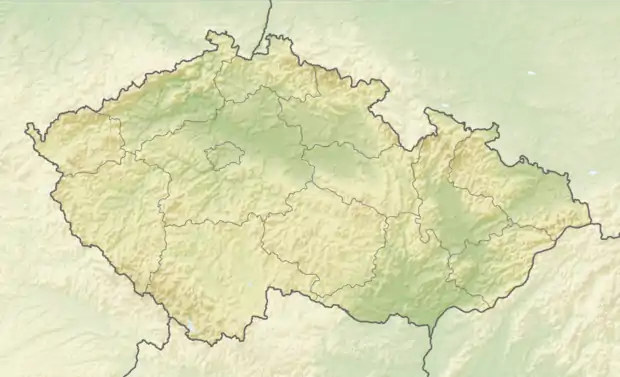Vyškov
Vyškov (Czech pronunciation: [ˈvɪʃkof]; German: Wischau) is a town in the South Moravian Region of the Czech Republic. It has around 21,000 inhabitants.
Vyškov | |
|---|---|
Town | |
 Church in Vyškov | |
 Flag  Coat of arms | |
 Vyškov Location in the Czech Republic | |
| Coordinates: 49°16′39″N 16°59′56″E | |
| Country | |
| Region | South Moravian |
| District | Vyškov |
| First mentioned | 1141 |
| Government | |
| • Mayor | Karel Jurka (ODS) |
| Area | |
| • Total | 50.40 km2 (19.46 sq mi) |
| Elevation | 254 m (833 ft) |
| Population (2020-01-01[1]) | |
| • Total | 20,807 |
| • Density | 410/km2 (1,100/sq mi) |
| Time zone | UTC+1 (CET) |
| • Summer (DST) | UTC+2 (CEST) |
| Postal code | 682 01 |
| Website | www |
History
By the middle of the 14th century, pest epidemics and starvation had virtually depopulated the entire area. The Catholic Church, the owners of the lands, administrated their properties via its cloisters in Bamberg, Augsburg and Brixen. These cloisters called upon German farmers to resettle the area. At that time the German-speaking area comprised about 60 villages, only eight of which, with a population of around 3,500, still existed by the time of the expulsion of the Germans after World War II.
The inhabitants were mostly farmers. Their lives consisted mainly of hard work. The population was Roman Catholic, and the rhythm of life was therefore mainly governed by the church and its festivities. An education in a German school was considered to be of great importance; six villages had their own German elementary school and the town of Lissowitz had a grammar school. As a result of the geographic separation from other German settlements, the language of these German-speaking inhabitants retained its original form to a great extent, and the area became a language island. It is a variety of a Southern German dialect. One peculiarity is that a "w" was pronounced very much like a "b."
After their expulsion, the former inhabitants of the area went to Germany, Austria and other countries. In 1949 an association, "Language Island of Wischau", was formed in the German town of Aalen to help the scattered families move together again.
Sights
The Vyškov Zoo opened in 1965. In 2006, a new Dinopark was opened, located about 2.5 kilometres (1.6 miles) outside the city in the former "Marchanice" park. There are currently around 30 life-size dinosaur models in the park, and it is one of the most visited attractions in the area.[2]
Sport
Vyškov has a top-level rugby team, RC Vyškov, who play in the KB Extraliga and have been national champions 11 times.
Notable people
- Andreas Zelinka (1802–1868), mayor of Vienna (1851–1860)
- Alois Musil (1868–1944), Austrian-Czech theologist, orientalist, explorer and writer
- Otto Planetta (1899–1934), Austrian Nazi politician who murdered Austrian Chancellor Engelbert Dollfuss
- Karel Kachyňa (1924–2004), film director
- Albert Rusnák (born 1994), Slovak footballer
Vyškov in literature
The town is mentioned in War and Peace, by Leo Tolstoy, in Book 3 Chapters 10 and 11.
Krambambuli, by Marie von Ebner-Eschenbach, a short story part of Dorf- und Schloßgeschichten (Village and castle stories), is also set in the town.
Twin towns – sister cities
 Cognac, France
Cognac, France Döbeln, Germany
Döbeln, Germany Jarosław, Poland
Jarosław, Poland Michalovce, Slovakia
Michalovce, Slovakia Virovitica, Croatia
Virovitica, Croatia
References
- "Population of Municipalities – 1 January 2020". Czech Statistical Office. 2020-04-30.
- "Most visited touristic destinations in 2015". CzechTourism. 2016-08-04. Retrieved 2019-05-22.
- "Partnerská města: Vyškov". vyskov-mesto.cz (in Czech). Město Vyškov. Retrieved 2020-08-28.
